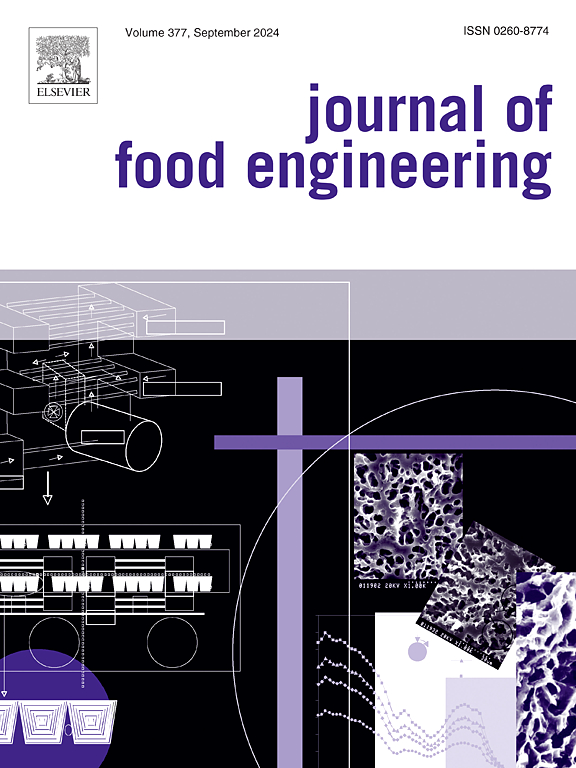Effect of dasher design and processing conditions on residence time distribution of ice cream produced with a continuous scraped surface freezer
IF 5.3
2区 农林科学
Q1 ENGINEERING, CHEMICAL
引用次数: 0
Abstract
The dasher assembly in scraped surface freezers (SSFs) plays a crucial role in the manufacture of ice cream by providing mixing during processing, removing ice from the heat exchange surface as it forms, creating fat structures, and incorporating air. Even so, very little is understood about how the design of dashers impacts frozen dessert development in SSFs. In this study, the effect of dasher design and processing parameters on the residence time distribution (RTD) of ice cream made in a continuous SSF was investigated. Processing parameters investigated included dasher speed, overrun, and throughput rate, while five dasher designs of varying geometries and volume displacements within the freezing cylinder were employed. Dye pulse injection studies were used to determine RTD properties while monitoring processing conditions including draw temperature, overrun, and amperage drawn on the dasher motor. Mean residence time was primarily driven by throughput rate, followed by dasher assembly, and then overrun. Reduced mean residence time was associated with higher throughput rates, higher dasher displacements, and lower overrun. Dasher rotational speed did not have a significant effect on mean residence time. There were two-way interaction effects between dasher design and dasher rotational speed, overrun, as well as throughput rate on residence time parameters (mean and/or variance). This study provides insight into the importance of dasher assembly design on the residence time and flow properties of a three-phase system in an SSF.
速冻机设计及加工条件对连续刮面冷冻机冰淇淋停留时间分布的影响
刮面冷冻机(ssf)中的冲碎器组件在冰淇淋的制造中起着至关重要的作用,它在加工过程中提供混合,在热交换表面形成时除去冰,产生脂肪结构,并吸收空气。即便如此,人们对速冻机的设计如何影响速冻甜点的发展仍然知之甚少。研究了速冻机设计和工艺参数对冰淇淋停留时间分布(RTD)的影响。研究的工艺参数包括冲床速度、超限和吞吐率,同时采用了五种不同几何形状和体积位移的冲床设计。染料脉冲注射研究用于确定RTD性能,同时监测加工条件,包括拉伸温度、超限和冲丝电机上的电流。平均停留时间主要由吞吐率决定,其次是冲碎机装配,然后是溢出。减少平均停留时间与更高的吞吐率、更高的冲冲位移和更低的溢出有关。粉碎机转速对平均停留时间无显著影响。冲料机设计与冲料机转速、超限以及处理率对停留时间参数(平均值和/或方差)存在双向交互作用。该研究深入了解了冲碎器总成设计对SSF三相系统停留时间和流动特性的重要性。
本文章由计算机程序翻译,如有差异,请以英文原文为准。
求助全文
约1分钟内获得全文
求助全文
来源期刊

Journal of Food Engineering
工程技术-工程:化工
CiteScore
11.80
自引率
5.50%
发文量
275
审稿时长
24 days
期刊介绍:
The journal publishes original research and review papers on any subject at the interface between food and engineering, particularly those of relevance to industry, including:
Engineering properties of foods, food physics and physical chemistry; processing, measurement, control, packaging, storage and distribution; engineering aspects of the design and production of novel foods and of food service and catering; design and operation of food processes, plant and equipment; economics of food engineering, including the economics of alternative processes.
Accounts of food engineering achievements are of particular value.
 求助内容:
求助内容: 应助结果提醒方式:
应助结果提醒方式:


